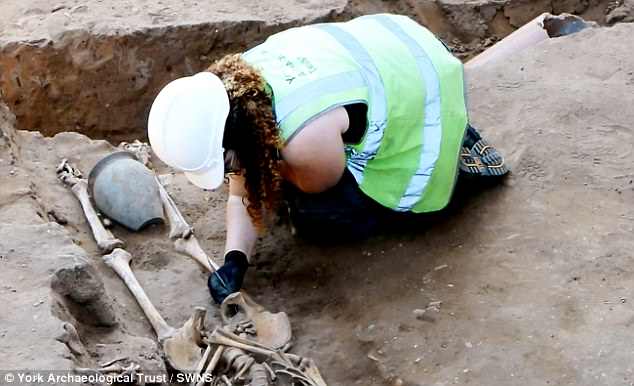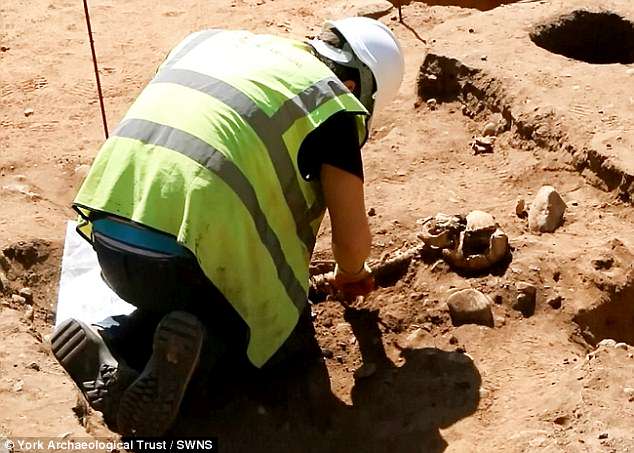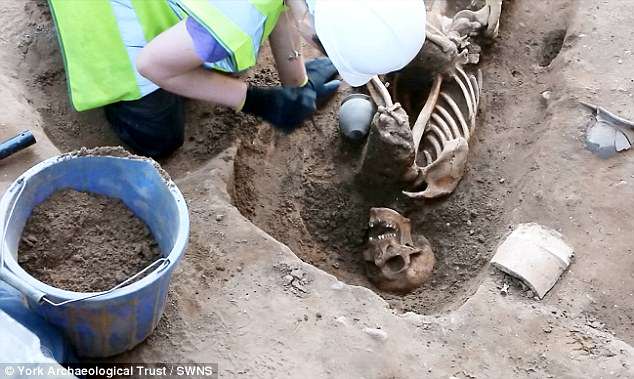A burial site containing 75 Roman skeletons has been uncovered beneath a hotel swimming pool in York.
The grade two listed building, known as the Newington Hotel, is currently being gutted by developers to create seven family homes.
During the renovation of the Georgian building, construction workers were stunned to find dozens of Roman human remains.
Scientists say the skeletons belong to both men and women of varying ages.
Dozens of Roman skeletons are discovered under a hotel swimming pool in York close to an ancient gladiator burial ground
Builders in York made the discovery during restoration of the Newington Hotel
Remains of 75 Romans of all ages dating as far back as 50 BC were uncovered
Some included large copper head pieces that had eroded to leave a green mark
The site is 1000ft away from a Roman gladiator burial site discovered in the city
It's not yet known if any of the bodies found also belonged to the fighters, but researchers think it is unlikely because the burial is 'demographically diverse'
By Tim Collins For Mailonline
25 April 2018
A burial site containing 75 Roman skeletons has been uncovered beneath a hotel swimming pool in York.
The grade two listed building, known as the Newington Hotel, is currently being gutted by developers to create seven family homes.
During the renovation of the Georgian building, construction workers were stunned to find dozens of Roman human remains.
Scientists say the skeletons belong to both men and women of varying ages.
They are still analysing the remains to find more clues about their background.
The newly-found skeletons are just 1000 ft away from a Roman gladiator burial discovered in the city in 2004.
It's not yet known if any of the newly-found bodies belong to fighters, but researchers believe this is unlikely.

A burial site containing 75 Roman skeletons has been uncovered beneath a hotel swimming pool in York.
During the restoration, the developers called in the York Archaeological Trust to assist with the recovery of the skeletons.
John Reeves chairman of developers the Helmsley Group, said: 'The refurb has not been without its issues.
'To start with there were over 60 Roman skeletons found under the old swimming pool, in what was an extension to a Roman burial ground further up Mount Vale.
'All had to be painstakingly removed, catalogued and investigated by the archaeological trust.'

The site is just 1,000 ft away from a Roman gladiator burial discovered in the city - it's not yet known if any of the bodies belonged to fighters

The grade two listed building, known as the Newington Hotel in Mount Vale Drive, is currently being gutted by developers to create seven family homes
Some remains, dating as far back as 50 BC, included large copper head pieces that had eroded to leave a green mark on the foreheads of the skulls of more wealthy citizens.
David Scott, from the York Archaeological Trust, said the find was not surprising due to the association with the Roman Empire, which has yielded dozens of finds in the past.
He added: 'The hotel is adjacent to a cemetery excavated by L P Wenham in the 1950s and it was one of the first Romano-British burial grounds to be fully published in this country.
'The site also lies about 300m from a previous excavation in 2004 and 2005 famously uncovered the graves of over 30 decapitated Romans, a number of whom were interpreted as possible gladiators.
'The excavations lasted three months and 75 graves have been recorded by the trust.
'The graves were, for the most part, strikingly shallow meaning that many of them had been damaged by ploughing throughout the medieval period and 19th century construction.'

Some remains, dating as far back as 50 BC, included large copper head pieces that had eroded to leave a green mark on the foreheads of more wealthy citizens

Builders are part-demolishing the Georgian property, the grade two listed Newington Hotel, to make way for seven homes. More than 60 skeletons found under the old swimming pool
The discovery is close to a gladiator burial ground discovered in where researchers excavated eighty burials at nearby Driffield Terrace in York.
This site was part of a large cemetery on the outskirts of the Roman town of Eboracum, across the river from the legionary fortress.
The 2004 burials displayed evidence that so intrigued archaeologists that further investigation was needed.
The male skeletons displayed deliberate trauma, interesting pathology and peri-mortem decapitation.
Many of the skeletons showed signs of healed injuries. One had even been bitten by a large predator, perhaps a lion or bear.
Strangest of all, about half were decapitated at or just after death and buried with their detached heads.
WHEN DID THE ROMANS OCCUPY BRITAIN?
55BC - Julius Caesar crossed the channel with around 10,000 soldiers. They landed at a beach in Deal and were met by a force of Britons. Caesar was forced to withdraw.
54BC - Caesar crossed the Channel with 27,000 infantry and cavalry. Again they landed at deal but were unopposed. They marched inland and after hard battles they defeated the Britons and key tribal leaders surrendered.
However, later that year, Caesar was forced to return to Gaul to deal with problems there and the Romans left.
54BC - 43BC - Although there were no Romans present in Britain during these years, their influence increased due to trade links.
43AD - A Roman force of 40,000 led by Aulus Plautius landed in Kent and took the south east. The emperor Claudius arrived in Colchester with reinforcements. Claudius appointed Plautius as Governor of Britain and returned to Rome.
47AD - Londinium (London) was founded and Britain was declared part of the Roman empire. Networks of roads were built across the country.
75 - 77AD - Romans defeated the last resistant tribes, making all Britain Roman. Many Britons started adopting Roman customs and law.
122AD - Emperor Hadrian ordered that a wall be built between England and Scotland to keep Scottish tribes out.
312AD - Emperor Constantine made Christianity legal throughout the Roman Empire.
228AD - The Romans were being attacked by barbarian tribes and soldiers stationed in the country started to be recalled to Rome.
410AD - All Romans were recalled to Rome and Emperor Honorious told Britons they no longer had a connection to Rome.
Source: History on the net
The grade two listed building, known as the Newington Hotel, is currently being gutted by developers to create seven family homes.
During the renovation of the Georgian building, construction workers were stunned to find dozens of Roman human remains.
Scientists say the skeletons belong to both men and women of varying ages.
Dozens of Roman skeletons are discovered under a hotel swimming pool in York close to an ancient gladiator burial ground
Builders in York made the discovery during restoration of the Newington Hotel
Remains of 75 Romans of all ages dating as far back as 50 BC were uncovered
Some included large copper head pieces that had eroded to leave a green mark
The site is 1000ft away from a Roman gladiator burial site discovered in the city
It's not yet known if any of the bodies found also belonged to the fighters, but researchers think it is unlikely because the burial is 'demographically diverse'
By Tim Collins For Mailonline
25 April 2018
A burial site containing 75 Roman skeletons has been uncovered beneath a hotel swimming pool in York.
The grade two listed building, known as the Newington Hotel, is currently being gutted by developers to create seven family homes.
During the renovation of the Georgian building, construction workers were stunned to find dozens of Roman human remains.
Scientists say the skeletons belong to both men and women of varying ages.
They are still analysing the remains to find more clues about their background.
The newly-found skeletons are just 1000 ft away from a Roman gladiator burial discovered in the city in 2004.
It's not yet known if any of the newly-found bodies belong to fighters, but researchers believe this is unlikely.

A burial site containing 75 Roman skeletons has been uncovered beneath a hotel swimming pool in York.
During the restoration, the developers called in the York Archaeological Trust to assist with the recovery of the skeletons.
John Reeves chairman of developers the Helmsley Group, said: 'The refurb has not been without its issues.
'To start with there were over 60 Roman skeletons found under the old swimming pool, in what was an extension to a Roman burial ground further up Mount Vale.
'All had to be painstakingly removed, catalogued and investigated by the archaeological trust.'

The site is just 1,000 ft away from a Roman gladiator burial discovered in the city - it's not yet known if any of the bodies belonged to fighters

The grade two listed building, known as the Newington Hotel in Mount Vale Drive, is currently being gutted by developers to create seven family homes
Some remains, dating as far back as 50 BC, included large copper head pieces that had eroded to leave a green mark on the foreheads of the skulls of more wealthy citizens.
David Scott, from the York Archaeological Trust, said the find was not surprising due to the association with the Roman Empire, which has yielded dozens of finds in the past.
He added: 'The hotel is adjacent to a cemetery excavated by L P Wenham in the 1950s and it was one of the first Romano-British burial grounds to be fully published in this country.
'The site also lies about 300m from a previous excavation in 2004 and 2005 famously uncovered the graves of over 30 decapitated Romans, a number of whom were interpreted as possible gladiators.
'The excavations lasted three months and 75 graves have been recorded by the trust.
'The graves were, for the most part, strikingly shallow meaning that many of them had been damaged by ploughing throughout the medieval period and 19th century construction.'

Some remains, dating as far back as 50 BC, included large copper head pieces that had eroded to leave a green mark on the foreheads of more wealthy citizens

Builders are part-demolishing the Georgian property, the grade two listed Newington Hotel, to make way for seven homes. More than 60 skeletons found under the old swimming pool
The discovery is close to a gladiator burial ground discovered in where researchers excavated eighty burials at nearby Driffield Terrace in York.
This site was part of a large cemetery on the outskirts of the Roman town of Eboracum, across the river from the legionary fortress.
The 2004 burials displayed evidence that so intrigued archaeologists that further investigation was needed.
The male skeletons displayed deliberate trauma, interesting pathology and peri-mortem decapitation.
Many of the skeletons showed signs of healed injuries. One had even been bitten by a large predator, perhaps a lion or bear.
Strangest of all, about half were decapitated at or just after death and buried with their detached heads.
WHEN DID THE ROMANS OCCUPY BRITAIN?
55BC - Julius Caesar crossed the channel with around 10,000 soldiers. They landed at a beach in Deal and were met by a force of Britons. Caesar was forced to withdraw.
54BC - Caesar crossed the Channel with 27,000 infantry and cavalry. Again they landed at deal but were unopposed. They marched inland and after hard battles they defeated the Britons and key tribal leaders surrendered.
However, later that year, Caesar was forced to return to Gaul to deal with problems there and the Romans left.
54BC - 43BC - Although there were no Romans present in Britain during these years, their influence increased due to trade links.
43AD - A Roman force of 40,000 led by Aulus Plautius landed in Kent and took the south east. The emperor Claudius arrived in Colchester with reinforcements. Claudius appointed Plautius as Governor of Britain and returned to Rome.
47AD - Londinium (London) was founded and Britain was declared part of the Roman empire. Networks of roads were built across the country.
75 - 77AD - Romans defeated the last resistant tribes, making all Britain Roman. Many Britons started adopting Roman customs and law.
122AD - Emperor Hadrian ordered that a wall be built between England and Scotland to keep Scottish tribes out.
312AD - Emperor Constantine made Christianity legal throughout the Roman Empire.
228AD - The Romans were being attacked by barbarian tribes and soldiers stationed in the country started to be recalled to Rome.
410AD - All Romans were recalled to Rome and Emperor Honorious told Britons they no longer had a connection to Rome.
Source: History on the net
Last edited: